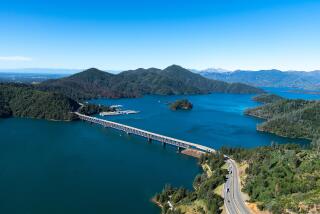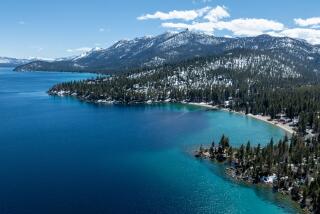Low Water Levels Raise Concerns
- Share via
MANISTEE, Mich. — A year ago, David Solberg was in trouble. The water at his marina near Lake Michigan had plummeted to less than a foot deep in places. Most of the 200 slips were unusable.
“I had a panic,” Solberg said. “To have a marina get down to 6 inches--that’s not low water. That’s catastrophic.”
He has survived, but only after paying $250,000 for dredging equipment to deepen his docking areas and channel leading to open water. Such is the cost of doing business on the Great Lakes during a slump in water levels, now in its fourth-consecutive year.
The decline of the world’s largest surface fresh-water system has caused millions of dollars in losses for shipping companies, marinas and other businesses in eight states and the Canadian provinces of Ontario and Quebec. It poses a headache for recreational boaters, leaving fewer places to launch and exposing hulls to collisions with stumps and boulders.
Forecasters say there is little hope of a quick turnaround because the summer has been so dry. And there’s a new wrinkle: global warming, which a federal report says could push down lake levels even farther.
“This summer has been sour, to the say the least,” says Roger Gauthier, supervising hydrologist with the U.S. Army Corps of Engineers in Detroit. “In fact, we’re now approaching the point where unless we get a very wet fall and winter, with substantial ice cover on Michigan and Huron . . . we could set record lows.”
Record-low water levels could be seen by January or February, when the lakes normally reach their lowest ebb of the year.
Piloting a 37-foot powerboat down the Manistee River, the link between Lake Michigan and Manistee Lake where his marina is located, Solberg points out signs of low water along the shoreline: previously submerged pilings from docks abandoned long ago; decaying remains of a sunken fishing boat; blackened water pipes. Scattered buoys warn boaters to keep a safe distance.
Sheldon Rosen of Toledo, Ohio, recently helped a friend sail a 39-foot boat from Lake Erie to Charlevoix on northern Lake Michigan.
“We ran aground three times in areas where normally we wouldn’t have had any trouble,” Rosen said. “You have to be very attentive.”
For each inch the lakes recede, 270 tons less cargo can be hauled, said Glen Nekvasil, spokesman for the Cleveland-based Lake Carriers Assn., which represents Great Lakes shippers.
The industry, which pumps $4 billion a year into the regional economy and provides about 70,000 jobs, has had to lighten loads of iron ore, coal and limestone. Result: more trips and higher costs.
Facing such grim prospects, people are making adjustments and learning to cope.
Since early 1998, more than 1,500 applications have been filed with the Army Corps of Engineers to dredge along the Michigan shoreline. The overwhelming majority were approved, said Patrick O’Connor, a biologist in the Detroit office.
Waterfront residents are lengthening private docks. Boaters are “using common sense, getting updated charts . . . becoming more familiar about the areas where they’re going to be operating,” said Van Snider, president of the 1,200-member Michigan Boating Industries Assn.
Although some marinas have gone out of business, others have stayed afloat by dealing in other products and services. Solberg sold 16 luxury boats last year, helping offset a steep drop in docking revenue from the usual $120,000 to about $37,000. After dredging for months, he’s been able to rent about 135 slips this summer.
Marge Mills, who runs a 59-slip marina in the northern Lake Michigan village of Elberta with her husband, last year worried they might have to close. Instead, they’re hanging on, renting dock space to smaller boats and making extra money from boat storage, a fishing tackle shop and an electric hoist that lifts vessels into and out of the water.
“We’re in the same predicament as last year, maybe a little better” because the area had a wet spring, Mills said.
Lake levels have ebbed and flowed for thousands of years, Gauthier said. Since the mid-1800s, scientists have noted fluctuations on roughly 30-year cycles. The lakes slumped in the 1930s and 1960s, so the decline that began in 1997 wasn’t entirely unexpected.
Yet the water retreated so far, so fast that many were caught off guard--particularly since the lakes had reached some of their highest levels ever in the mid-1990s.
Lakes Michigan and Huron are about 3 1/2 feet below their July 1997 levels. So is Lake St. Clair, which isn’t one of the Great Lakes but links Erie and Huron. Erie is down 3 feet, and Superior and Ontario about 1 foot.
The culprit: a long stretch of unusually warm, dry weather. Ice cover that normally limits evaporation in winter was considerably smaller or nonexistent. Snowfall, which replenishes the lakes during the spring melt, was drastically reduced.
Conditions would have gotten a lot worse this year but for a rainy spring across the upper Great Lakes. Superior, the biggest lake, rose 11 inches in one month as its watershed experienced the wettest April on record.
Still, several years of above-average precipitation and cold winters are needed to turn things around, said Michael Donahue, executive director of the Great Lakes Commission, a research and advisory organization.
“The Great Lakes basin is like a sponge,” Donahue said. “When you have dry conditions like we’ve had in recent years, a whole lot of rainfall will go into the sponge before it runs off” into the lakes and their tributaries.
Michigan and Huron remain 20 inches below their long-term average level, while Superior is 4 inches down and Ontario 2 inches off. Erie, the shallowest, is 9 inches below its long-term average and St. Clair is down 10 inches.
And that was before the lakes, which peak in midsummer, begin their seasonal decline.
The worst may be yet to come. Scientists say the lakes may rise for brief periods over the next century, but for the most part are likely to continue their retreat--especially if predictions of a hotter planet prove accurate.
Last December, researchers studying possible effects of global warming said it could reduce lake levels more than 2 feet by 2030 and 5 feet by the century’s end.
“With the increase of carbon dioxide in the atmosphere, we expect warmer winters, hence more evaporation,” said lead researcher Peter Sousounis, associate professor of atmospheric science at Michigan State University.
Among possible results: declines in hydroelectric power generation; more pollution as dredging spreads toxins that had been buried in sediment; loss of aquatic plants and animals as warming temperatures reduce the lakes’ oxygen content.
Sousounis acknowledged the study was based on computer models and made no guarantees, and that other models actually predicted a slight rise in lake levels. Some scientists contend years of additional work is needed to establish a definite link between global warming and low water.
Still, it’s not too early to prepare for the worst, Sousounis said. Even if carbon dioxide emissions were cut immediately, it would take a half-century for the beneficial effects to show up.
The message is starting to sink in.
Governors of the eight Great Lakes states and the premiers of Ontario and Quebec agreed in June to tighten standards for water withdrawals. They were responding to fears that pressure will mount to tap the lakes, which contain 20% of the world’s fresh surface water, as the thirsty Sun Belt gains population and political clout.
Environmentalists applauded the decision, but said people in the Great Lakes basin should set a good example by conserving water and improving its quality. And, said Tanya Cabala, coordinator of land and water conservation for the Lake Michigan Federation, people should avoid the temptation to overdevelop newly emerging shorelines and wetlands.
“We have to remember,” she said, “that the coastlines are dynamic and the water can rise again.”
More to Read
Sign up for Essential California
The most important California stories and recommendations in your inbox every morning.
You may occasionally receive promotional content from the Los Angeles Times.













